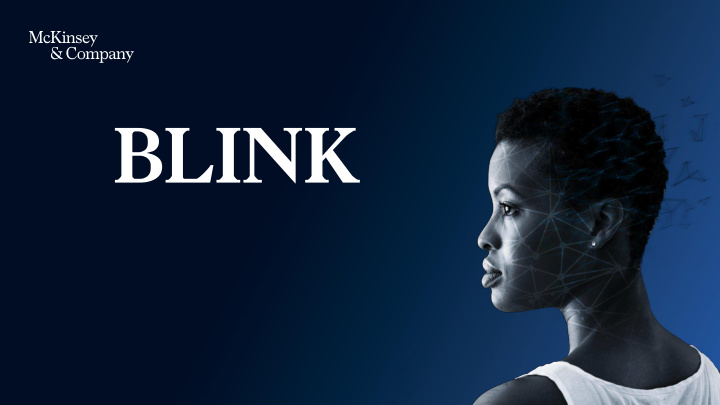



McKinsey & Company
The future of mobility is NOW! Breakout session 14 th November 2019 CONFIDENTIAL AND PROPRIETARY Any use of this material without specific permission of McKinsey & Company is strictly prohibited
Agenda Phasing for our session Opening comments and introductions Thoughts from Laurel Powers-Freeling, Uber, and Q&A Thoughts from Shashi Verma, Transport for London, and Q&A Panel discussion and Q&A — Laurel, Shashi, Swarna Ramanathan (McKinsey) and James Stamp (National Express) McKinsey & Company 3
How could the future look in 2030? Baseline Business as usual Unconstrained autonomy Seamless mobility Baseline city faces Urbanisation and population Electrification and Cities encourage the use of challenges today, with trip growth increase passenger automation take off , but shared AVs through times averaging over 30 km demand, with limited regulators and city regulation and incentives. Residents ‘mix and match’ minutes , congestion rising, regulatory/city government governments fail to keep up . and air quality challenges shaping of the future. Pace Robo-taxis take a greater rail transit and low-cost, point of electrification and share than AV shuttles, to point autonomous travel in automation disappoints. contributing to congestion. AV shuttles easily Congestion, time per trip, 10% 15% 10% delta from baseline McKinsey & Company SOURCE: McKinsey Center for Future Mobility McKinsey & Company 4
Agenda Phasing for our session Opening comments and introductions Thoughts from Laurel Powers-Freeling, Uber, and Q&A Thoughts from Shashi Verma, Transport for London, and Q&A Panel discussion and Q&A — Laurel, Shashi, Swarna Ramanathan (McKinsey) and James Stamp (National Express) McKinsey & Company 5
Agenda Phasing for our session Opening comments and introductions Thoughts from Laurel Powers-Freeling, Uber, and Q&A Thoughts from Shashi Verma, Transport for London, and Q&A Panel discussion and Q&A — Laurel, Shashi, Swarna Ramanathan (McKinsey) and James Stamp (National Express) McKinsey & Company 6
Innovating for cities Shashi Verma Director of Strategy and Chief Technology Officer Transport for London EVERY JOURNEY MATTERS EVERY JOURNEY MATTERS
Growth in selected modes of travel 240 220 200 Index: 2001 = 100 180 What are the 160 growth markets for transport in 140 London 120 Public transport has seen 100 very substantial growth in London, removing the needs for car trips 80 Cycling has seen the fastest growth, starting from a small base Rail Underground Bus Car driver Population Cycle
Share of all trips by mode of travel Total = 26.9 million trips per day Motorcycle Taxi 1% Cycle 1% 2% Underground/DLR Car 11% 36% Rail 11% How do people travel? Bus (including tram) Most innovation talk is 14% about areas that don’t Walk matter much for how cities 24% work. The only significant exception is autonomous vehicles, as and when they are made viable
Rail Buses Autonomous vehicles Useful What drives investment? e-Scooter Innovation needs to focus on Drones not just what is cool but also what is useful. There is no money in being cool alone. Cool
Agenda Phasing for our session Opening comments and introductions Thoughts from Laurel Powers-Freeling, Uber, and Q&A Thoughts from Shashi Verma, Transport for London, and Q&A Panel discussion and Q&A — Laurel, Shashi, Swarna Ramanathan (McKinsey) and James Stamp (National Express) McKinsey & Company 11
What role can we all play in creating seamless mobility? Optimise supply Optimise demand Optimise rail Shift to shared modes ▪ Autonomous train operations ▪ Dedicated lanes for shared vehicles ▪ Advanced signaling ▪ Bikes and e-scooters for last-mile ▪ Predictive maintenance ▪ Active management of the for-hire fleet Optimise road modes Shifting demand off-peak ▪ Intelligent traffic systems ▪ Congestion pricing ▪ Smart parking ▪ Commercial deliveries ▪ AV-readiness Improve sustainability Electrify transit Low-emission zones McKinsey & Company McKinsey & Company 12
The modal share by scenario for a city like London Amount of mobility in example dense metropolitan area, Passenger km/yr 1 130 125 Private Car 10% 115 15% 100 1 20% Robotaxi 35% 25% 35% Car 25% AV Shuttle 10% 20% 5% 20% Bus 2 40% Train 40% 40% Train 40% 5% 5% Walk/bike 5% Walk/bike 5% Baseline Business as usual Unconstrained Seamless mobility urbanization autonomy Congestion, 10% 15% 10% time per trip Urban leaders and private companies have an opportunity to actively shape the transit system over the next decade, reducing congestion by 10% from today even while accommodating 30% more traffic 1 Mobility demand indexed as baseline = 100 McKinsey & Company SOURCE: McKinsey (FoM 3 Urban Mobility Model). Figures are rounded to nearest 5%. McKinsey & Company 13
Recommend
More recommend